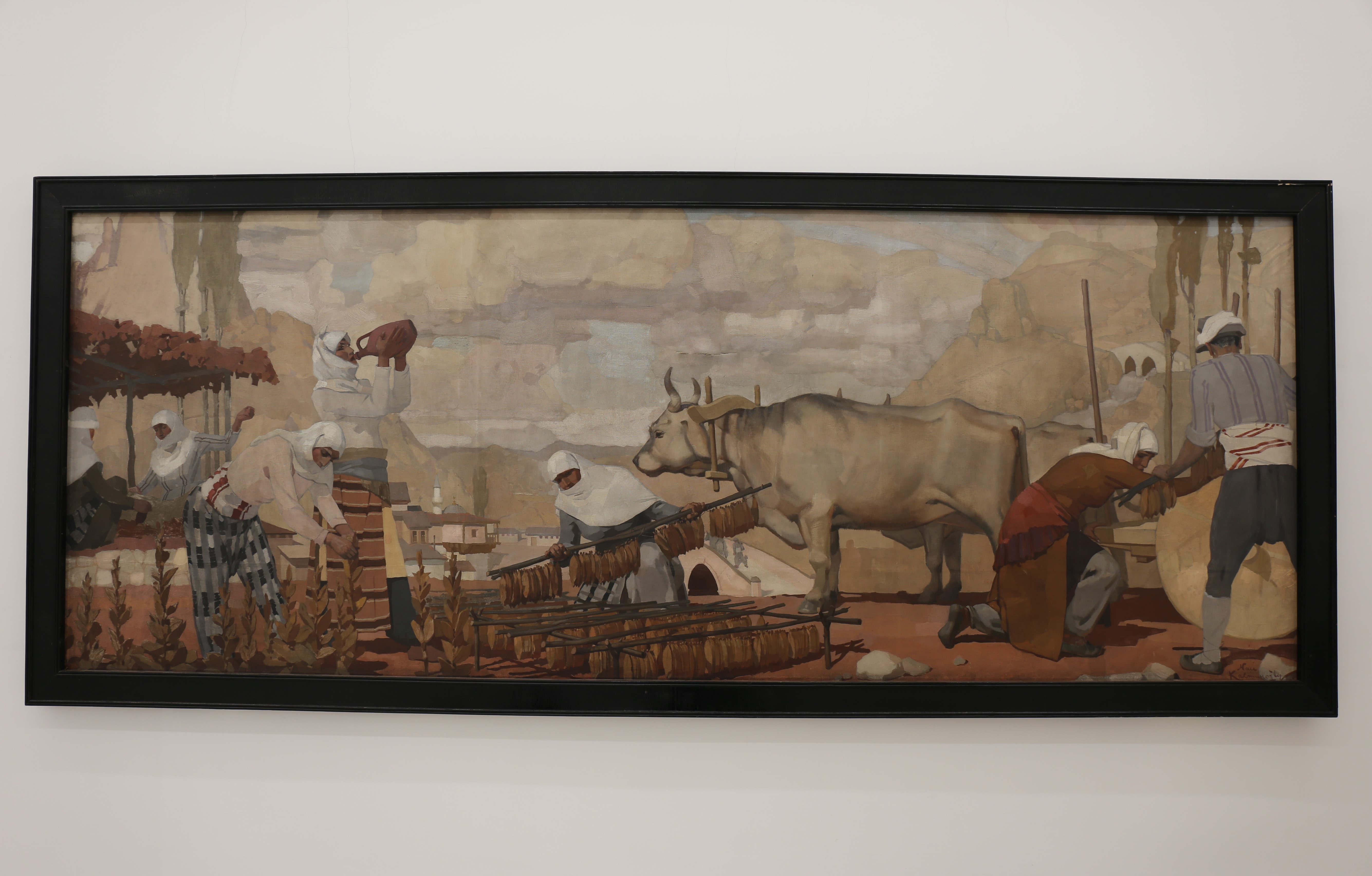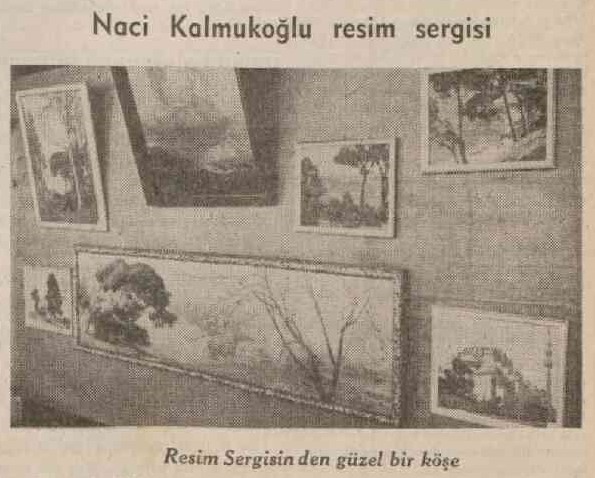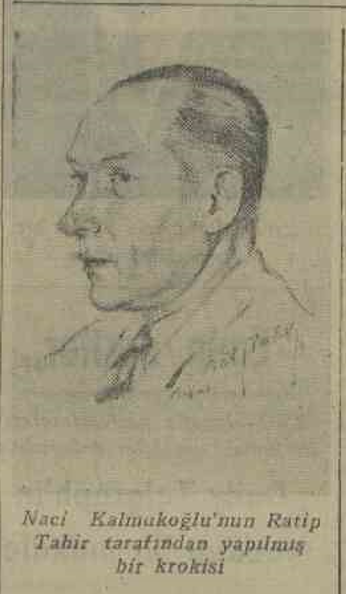Archive
Nikolai Kalmykoff
- Nikolai
- Kalmykoff
Николай Калмыков, Nicola Kalmikof, Naci Kalmukoğlu
- 1896
- Kharkiv (UA)
- 03-02-1951
- Istanbul (TR)
- PainterScene DesignerMuralist
Kalmykoff played an active part in the Union of Russian Painters in Constantinople and at the same time worked as a stage designer. Later he acquired the Turkish citizenship.
Word Count: 29

Nikolai Kalmykoff (http://www.antikalar.com/naci-kalmukoglu). 
Nikolai Kalmykoff (http://www.antikalar.com/naci-kalmukoglu). 
Naci Kalmukoğlu, Liman (© Ankara Devlet Resim ve Heykel Müzesi). 
Naci Kalmukoğlu, Köyde tütün işleyenler (© Ankara Devlet Resim ve Heykel Müzesi). 
Works by Nikolai Kalmykoff (Ulus, 12 February 1941, p. 2). 
Works by Nikolai Kalmykoff (Ulus, 13 February 1941, p. 1). 
Nikolai Kalmykoff by Turkish caricaturist Ratip Tahir Burak (Ulus, 27 March 1943, p. 2). 
Exhibition in Ankara (Ulus, 28 March 1943, p. 2). 
Fortuneteller, by Nikolai Kalmykoff (Ulus, 15 November 1947, p. 3). Anonymous. “Vystavka Soyuza Russkih Hudojnikov.” Presse du Soir, 19 June 1922, n.p.
Anonymous. “Vystavka Russkih Hudojnikov.” Presse du Soir, 8 December 1922, p. 3.
Anonymous. “Na Vystavke Kartin.” Presse du Soir, 3 February 1923, n.p.
Dostal, Halilhan, et al. Naci Kalmukoğlu: o bir yıldızdı = He was a star = Il était une étoile. İzmir: Arkas Sanat Merkezi, 2016.
Leykind, Oleg, et al. Hudojniki Russkogo Zarubej’ya (1). Izd.dom “Mir”, 2019, pp. 600–601.
Sığırcı, Marina. Spasibo, Konstantinopol’! Po sledam beloemigrantov v Turtsii. “Yevropeyskiy Dom”, 2018.
Toros, Taha. “Naci Kalmukoğlu.” antikalar.com, http://www.antikalar.com/naci-kalmukoglu. Accessed 14 June 2020.
Word Count: 92
State Art and Sculpture Museum in Ankara.
Slavonic Library (Slovanská knihovna) in Prague.
Word Count: 13
Istanbul, Ottoman Empire/Turkey (1920–1951).
Bursa Street 40 (now Sadri Alışık 40), Beyoğlu, Istanbul (studio); Küçük Yazıcı 4 (now presumably Tarlabaşı Blv. 79), Hüseyinağa, Beyoğlu, Istanbul (studio); Theatre des Petits Champs, Mezarlık Street 500 (now Meşrutiyet Caddesi 50), Beyoğlu, Istanbul (place of work); Bekar Sokak 9, Beyoğlu, Istanbul (residence and studio).
- Istanbul
- Ekaterina Aygün. "Nikolai Kalmykoff." METROMOD Archive, 2021, https://archive.metromod.net/viewer.p/69/2949/object/5138-10440314, last modified: 14-09-2021.
-
Vladimir BobritskyPainterScene DesignerGraphic ArtistMusicianIstanbul
Bobritsky worked at the Theatre des Petits Champs, where he successfully dealt with stage designs and costumes, at the same time he participated in the Union of Russian Painters in Constantinople.
Word Count: 31
Nikolai SaraphanoffPainterIllustratorIstanbulThe artist is known for his numerous works with views of Istanbul, the design of the famous almanac’s cover, and the creation of decorative panels. Alas, his artistic activities were interrupted by his imprisonment.
Word Count: 35
Leonid TomiloffScene DesignerDecoratorIstanbulAs a professional scene-designer, Leonid Tomiloff was in high demand in Istanbul. For many years, he worked at the Theatre des Petits Champs and was the chief decorator of the Constantinople Commercial Club.
Word Count: 33
Roman BilinskiPainterSculptorCollectorArt restorerIstanbulAt the beginning of the 1920s, a member of the Union of Russian Painters in Constantinople, Roman Bilinski was known as a sculptor. At the end of the 1920s–beginning of the 1930s – as a sculptor, painter and connoisseur of local antiques.
Word Count: 42
Ismet Inönü HeykeliMonumentIstanbulBetween 1941 and 1944 the Berlin sculptor Rudolf Belling worked on the Ismet Inönü Heykeli. The monument was placed in the neighbourhood of Maçka.
Word Count: 24
Exhibition of Russian émigré artists at Taksim Military BarracksExhibitionIstanbulThe exhibition of Russian-speaking émigré artists at Taksim Military Barracks was the first major exhibition organised by the Union of Russian Painters in Constantinople.
Word Count: 24
Union of Russian Painters in ConstantinopleAssociationIstanbulThe Union existed for less than two years but in that short space of time a tremendous amount of work was done by its members, refugees from the Russian Empire.
Word Count: 30
Konstantinopol’skiy Kommercheskiy KlubClubIstanbulKKK was probably the most popular Russian club in Beyoğlu district between 1924 and 1926. Not only Russian émigrés but also local residents could enjoy its constantly updated entertainment programme.
Word Count: 30
Alexis GritchenkoPainterArt HistorianIstanbulDuring the two years of his life that he spent in Istanbul, Alexis Gritchenko produced more paintings dedicated to the city than many artists produce in an entire lifetime.
Word Count: 29
Jules KanzlerPainterPhotographerIstanbulKanzler spent part of his life in the Russian Empire as a painter and the other in Turkey as a photographer who “documented” the early years of the Turkish Republic.
Word Count: 30
Wladimir IvanoffPainterSculptorIstanbulNot only did Ivanoff become one of the founders and chairman of the Union of Russian Painters in Constantinople, but he also became famous for “Drawing Thursdays”, which took place at his apartment.
Word Count: 33